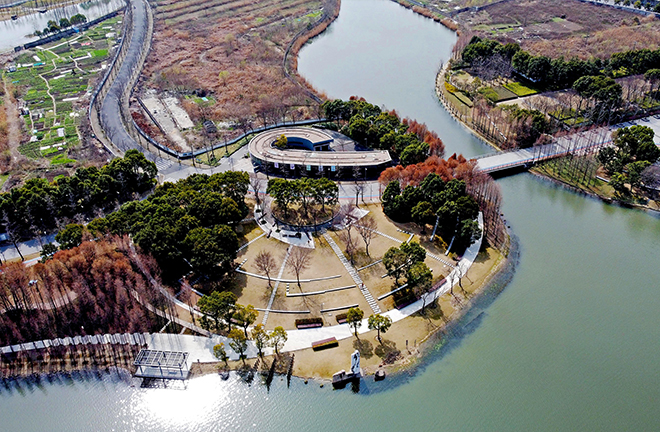
An anerial photo of Jiading District, Shanghai, which is one of the important targeted areas for city cluster building in Yangtze River Delta. Photo: Yin Liqin/CNSphoto
The Fifth Plenary Session of the 19th Central Committee of the Communist Party of China (CPC) clearly put forward the accelerated building of a new development pattern of “dual circulation” which takes domestic circulation as the mainstay and lets domestic circulation and international circulation reinforce each other. Proposed based on changing circumstances in both China today and within the coming period, the new development pattern is a strategic measure that aims to forge new advantages for China’s international cooperation and competition. As China’s most economically active region with the highest degree of openness and strongest innovative ability, the Yangtze River Delta shoulders the important mission of pioneering the new development pattern.
To foster the integrated development of the Yangtze River Delta under the guidance of “dual circulation,” systematic concepts are needed in practice. While promoting connectivity between the Yangtze River Delta and other regions both at home and abroad, factors within the delta itself should be optimized.
The first priority is to coordinate the promotion of “large circulation” both domestically and internationally. As the international situation is capricious, with volatile changes, the global economic structure is undergoing significant adjustments. Given this global context, it is necessary for China to expand domestic demand as the strategic basis and make full use of the two types of markets and two types of resources both domestically and internationally to improve the country’s resource distribution ability across the globe. On one hand, the advantage of a super large-scale domestic market should be utilized to enlarge demand for investment and expand the scope for investment. On the other hand, supply systems in line with the structure of domestic demand are needed to satisfy people’s consumption demands and stir their consumption ability.
The second priority is to foster the “small circulation” of both the Yangtze River Delta and other regions. The coordination between the delta and other city clusters in China needs to be strengthened, At the same time, it is important to advance cooperation between the delta and Western, Central regions as well as old industrial bases in the Northeastern region of China. The flow of resource elements such as finance, technology, talent, information, and more, from the delta to these regions should be expedited.
The next priority is to foster “micro circulation” within the Yangtze River Delta. A top-down design can be implemented aimed at integrating development within the delta. The targeted key areas should include the Model Zone of Ecological and Green Development of Yangtze River Delta, Lin-Gang Special Area of Shanghai Pilot Free Trade Zone, Hongqiao Business District, and Pudong District.
With a strong manufacturing industry as the foundation, the Yangtze River Delta ranks in China’s top list in terms of its industrialization and informatization, and the region features great economic resilience and development momentum. The role of the delta in the global industrial chain and supply chain thus needs to be improved with manufacturing industry as the core.
To achieve this, the stability, security, and competitiveness of the industrial chain and supply chain in the delta should be effectively enhanced. It is advised that impediments and blocks to the logistics, personnel mobility, cash flow, and information flow of the chains, should be removed.
The second recommendation is to boost the modern industrial system. While ensuring leading industry upgrades in the delta, industries such as integrated circuits, biomedicine, high-end equipment, and other advanced manufacturing industries are essential to building industrial clusters in the delta.
The next recommendation is to build world-class industrial clusters, particularly manufacturing industrial clusters that are internationally competitive. Attention should also be paid to the regions adjacent to the Yangtze River Delta for coordinated development of cross-regional industrial clusters.
As the Yangtze River Delta pioneers the formation of the new development pattern, it does not mean the denial of international circulation or the pursuit of closed domestic circulation. Rather, dual circulation that features both domestic and international circulation should reach a higher level which is more open. On the basis of consolidating and extending international circulation, the role and function of domestic circulation can be further enhanced.
Cheng Changchun and Wu Jianwen are from the Institute of Yangzi River Economic Belt Research at Nantong University.
Edited by BAI LE

